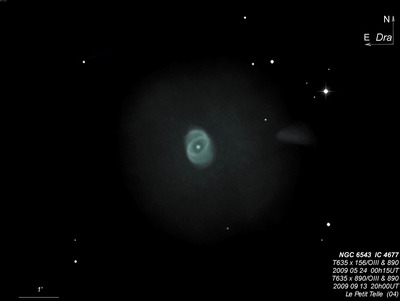Cat's Eye Nebula
Cat's Eye Nebula

William Herschel discovered NGC 6543 = H IV-37 on 15 Feb 1786 (sweep 523) and recorded "vB, about 35" diameter. A planetary disk, but very ill defined edge; the center of it is rather more luminous than the rest. With long attention a very bright, well defined, round center becomes visible. This seems to be a nebula that connects my former planetary ones with two other sorts; viz with those that are very bright in the middle and suddenly grow more diluted; and with those that have a bright central star, or nucleus and a milky chevelure."
In 1790, Lalande included this object as a 9th magnitude "star" (LL 38303 in his major star catalogue. Giuseppe Bianchi independently rediscovered it on 16 Jun 1839 and announced the discovery an Astronomische Nachrichten letter, apparently unaware of WH's prior discovery (there were many similar cases). Surprisingly, NGC 6543 does not appear in John Herschel's Slough catalogue, which was more accessible and easier to check than WH's catalogues.
Sir William Huggins examined NGC 6543 with a spectroscope on 29 Aug 1864 (the same night he viewed NGC 6572, 6828, 6818, 7009, 6720, 7662, 6853). He wrote "On the evening of the 29th of August, 1864, I directed the telescope for the first time to a planetary nebula in Draco [NGC 6543]. The reader may now be able to picture to himself to some extent the feeling of excited suspense, mingled with a degree of awe, with which, after a few moments of hesitation, I put my eye to the spectroscope. Was I not about to look into a secret place of creation? I looked into the spectroscope. No spectrum such as I expected ! A single bright line only!" At first, I suspected some displacement of the prism, and that I was looking at a reflection of the illuminated slit from one of its faces. This thought was scarcely more than momentary; then the true interpretation flashed upon me. The light of the nebula was monochromatic, and so, unlike any other light I had as yet subjected to prismatic examination, could not be extended out to form a complete spectrum." Based on subsequent observations, Huggins showed nebulae had bright [OIII] emission lines, unlike the broad spectrum expected of unresolved stars. He concluded these objects were enormous masses of hot luminous gas or vapour which would never be resolved into stars.
The 1888 paper "Observations of Nebulae at the Lick Observatory" (1888MNRAS..48..388H) included a schematic labeled "Helical Nebula in Draco (Holden)" showing two overlapping ellipses or coils, along with a detailed sketch and description of the nebula. Heber Curtis wrote "We have, therefore, ventured to designate this object as a helical nebula - the first of its class - because its brighter portions unquestionably appear to the eye in a helical and not simply in a spiral form; and also because it seems to us at least probable that the real disposition of the brighter parts in space may be in the form of a helix." Generally, the nickname "Cat's Eye Nebula" is used today.
E.E. Barnard discovered IC 4677, a shock-excited knot in the outer halo of NGC 6543, on 24 Apr 1900 with the 40-inch Yerkes refractor. See Harold Corwin's notes.
200/250mm - 8" (7/27/84): bright, elongated, blue, high surface brightness.
300/350mm - 13.1" (7/27/84): at 400x appears very bright, oval N-S, blue color, central star visible with averted.
400/500mm - 17.5" (6/11/88): viewed at 280x and 412x; the Cat's Eye nebula appears very bright, fairly small, oval SW-NE, blue-green color. Appears darker (annular) surrounding the mag 11 central star. The prominent visual portion is surrounded by a very faint oval outer envelope (386") which was not seen but includes the bright irregular knot IC 4677 1.7' W of center. NGC 6552 is located 10' following. IC 4677 was suspected at 220x without filtration close to a mag 15 star located 1' W of the planetary. Using a UHC filter, IC 4677 was clearly visible with averted vision as a very faint elongated patch, ~25"x15" oriented SW-NE. Requires averted for a good view but could hold steadily almost continuously. It was also visible at 140x with an OIII filter and 280x with the UHC, but 220x provided the best view.
900/1200mm - 48" (4/1/11): the extremely bright inner section [22"x19"] of the Cat's Eye was a vivid green color at 375x. But besides the bright central star I didn't take notes on the interior structure. A fairly faint (middle) halo was easily visible, extending ~1.4' diameter and dramatically increased the generally observed size. This halo had a well-defined periphery and was slightly elongated N-S or the border on the east and west sides were very slightly flattened. A very faint star is near the west edge.
Surrounding the middle shell is a much larger and fainter outer halo that extends ~5' in diameter. IC 4677 appeared as a prominent, triangular or wedge-shaped knot with the vertex pointing east, situated 1.8' due west of center near the edge of this outer halo. It appeared much larger than previously seen, ~50"x30", and brighter along a well-defined, straight southern edge. The north side is brightest near the east end at the vertex. A 15th magnitude star lies 45" NE and a mag 9.8 star is 1.2' NW. A second fainter knot in the outer halo is located 2.6' ESE of center, just 30" N of a mag 14.5 star. This knot was only 15"-20" in size and had a low surface brightness.
Notes by Steve Gottlieb